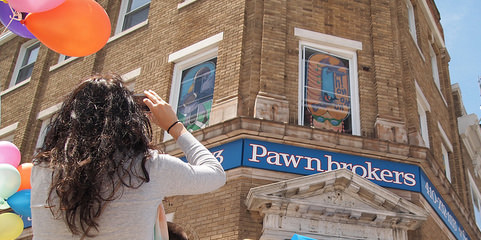Celebrating over a century of screen painting, colorful new window screens are being installed all over Highlandtown, at the very heart of the neighborhoods where this summertime tradition began and flourished. Scroll down to see some of our new screens!
Honoring the beautiful work done in the past, new artists are engaging in this vibrant Baltimore tradition, adding diversity to the classic cottage scenes popularized by William Oktavec, who first introduced Baltimore to the painted screen. Find out more about how painted screens got started in Baltimore.
T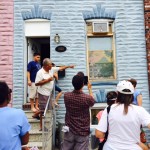 ake a tour!
ake a tour!
Unique walking tours of Highlandtown’s painted screen are available! For more information or to request a tour, contact Amanda at amanda@southeastcdc.org.
For a self-guided tour, download this painted screen tour of Highlandtown brochure, use this map to discover even more painted screens and check out the painted screen photo tour which highlights additional distinctive details you may want to look out for on your next visit to Highlandtown, including formstone seals, window displays, colorful local art, and of course, more painted screens!
Want your own painted screen?
Want to have painted screens on your home or business? Find an artist through The Painted Screen Society of Baltimore.
Want to become a screen painter?
Are you artistically inclined and interested in taking part in this Baltimore tradition? Enjoy this step by step tutorial on how-to paint a window screen created by talented local screen painter Anna Pasqualucci.
Baltimore’s painted screens are making headlines
- AP:Keeping Baltimore’s painted window screens alive
- Seattle PI:Baltimore: Poe, painted screens, vintage treasures”
- Washington Post:Keeping Baltimore’s painted window screens alive
- Baltimore Guide100 screens for 100 years: Main Street businesses and Painted Screen Society celebrate an East Baltimore art form
- CBS Sunday Morning Baltimore’s Painted Screens
FEATURED PAINTED SCREENS
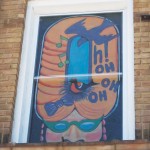
3517 Eastern Ave
Southeast Jewelry & Loan
John Oktavec & Anna Pasqualucci 2013
Kicking the painted screen project off in style, John Oktavec, direct descendant of the father of painted screens in Baltimore, William Oktavec, partnered with the wonderful Anna Pasqualucci, to create a big Baltimore Welcome on the second story of Southeast Jewelry & Loan. John Oktavec follows in the creative footsteps of his grandfather, William and his father Richard who passed on this important local tradition.
Anna Pasqualucci recorded her memories of her early experience with painted screens, “When I was a little girl, I remember riding through Baltimore City in my dad’s 1960’s Dodge. My dad would point out the colorful pictures on the windows of rowhouses. I would strain my neck and intently search over the car dashboard for the mesmerizing painted screens, anxious to see what the next window and then the next would have painted on it. Years later, the impression of those wondrous screens remains. “
Each letter of the ‘W-E-L-C-O-M-E’ screen has iconic Baltimore symbolism, the letter ‘C’ has a Raven playing football, the letter ‘O’ is a Baltimore Hon with an Oriole nesting in her bouffant.
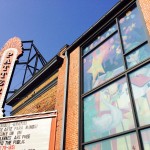
3134 Eastern Ave
Creative Alliance
Nancy Scheinman, Maura Dwyer, Hanna Moran, 2015
The Creative Alliance at the Patterson’s painted screens celebrate the annual Great Halloween Lantern Parade and Festival at Patterson Park. Since 1999, participants have made lanterns for the parade as part of a popular Halloween tradition. The pre-parade family-friendly festival has a kid’s costume contest, free activities, craft vendors, and food trucks. Each year about a thousand neighbor-made lanterns sparkle brilliantly as the parade winds through the park. The celebration concludes with an adults-only dance party at the Creative Alliance.
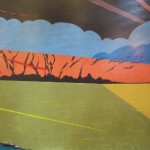
3600 Eastern Ave
Spartans Pizzeria
Monica Broere 2013
Spartan’s Pizzeria is known for more than just pizzas, like their Stromboli sandwiches, subs and Greek and Italian entrees. Monica Broere’s unique play on the traditional Baltimore painted screen is on display here as well, highlighting the characteristic cottage and swan paired with a modern graphic skyscape. A resident artist in Highlandtown, Monica has embraced this changing community for over 35 years. You might spot her subtly decorated storefront windows in her studio space a block west on Highland Ave displaying various works in wood or raku fired pottery and look up to see her delightfully graphic painted screens.
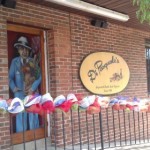
3700 Gough St
Di Pasquale’s Italian Marketplace
Anna Pasqualucci 2014
In 1914, Luigi Di Pasquale left Abruzzi, Italy to make Baltimore his home. He opened a corner store in Highlandtown, which has been run continuously by four generations of Di Pasquales, and is now a thriving neighborhood destination winning many awards for its authentic Italian specialty goods. In the early 1920s, Chicago gangster Al Capone worked as a bookkeeper for the Aiello family, local builders who owned several buildings in the neighborhood. It is reputed that Capone hid out on the second floor of the very same converted Baltimore rowhouse that is currently home to Di Pasquale’s. It is only appropriate you can catch a glimpse of him in the doorway of this wonderful historic Italian grocery and restaurant in Anna Pasqualucci’s beautiful painted screen.
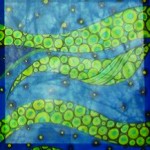 248 S Conkling St
248 S Conkling St
Highlandtown Gallery
Debbie Lynn Zwiebach 2014
Local artist Debbie Lynn Zweibach’s elaborate designs, reminiscent of underwater creatures and swirling smoke made up of intricate layered shapes, line and color bring the upper windows of the Highlandtown Gallery to life. Gallery owner Felicia Zannino-Baker beautifully restored and improved the old-fashioned corner store on a quiet Highlandtown street to become an elegant place where local artists show their work and attract local collectors.
“As a corner store, it served many purposes over time. It was a pharmacy and a tailor’s shop. It was always a mini-anchor in the neighborhood. As this community has evolved, so have its merchants,” Felicia recalled, as she grew up across the street. Quote from the Baltimore Sun.
It continues to serve as a neighborhood anchor adding to the wonderful art embracing culture of Highlandtown.
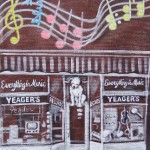
3300 Eastern Ave (front along Eastern Ave)
Ma’isa Mart, formerly Yeager’s Music
Anna Pasqualucci 2013
The inspiration for the old-fashioned sepia-toned “Yeager Music Shop” screens on the South side of the building came from the granddaughter of the store’s founder who wanted to commemorate the family-run music store formerly at this address. Once a favorite haunt of Arthur Godfrey, also known as “Old Redhead” when he worked for WFBR in the 1930s, Yeager’s Music store dominated this block until closing in the 1970s. It dealt in records, musical instruments, music lessons and sheet music and many residents still hold fond memories of this favorite Highlandtown hangout.
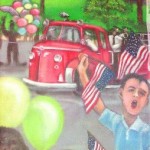
3300 Eastern Ave (side along Clinton St)
Ma’isa Mart, formerly Yeager’s Music
Anna Pasqualucci 2013
Started in 1938 by the Hearst Corp., publisher of the old Baltimore News American, the “I am an American” Day Parade was celebrated in Baltimore for 57 years the Sunday after Labor Day on Eastern Avenue in Highlandtown. People of all nationalities came together in community pride to celebrate freedom and independence. The first grand marshal of the parade was General Douglas MacArthur. In the 1930s and 40s the parade brought in hundreds of thousands to view the spectacle, some setting up lawn chairs at six in the morning. The 1954 parade welcomed the Baltimore Orioles (formerly the St. Louis Browns). Rising Baltimore City fees for crowd control and clean-up ended the Parade’s long run in Highlandtown in 1993, but there are many who would welcome its return. Anna’s patriotic paintings of the parade featured on the West side of the building remind residents that regardless of our diverse nationalities, we are all here working and living together. Check out this “I Am An American” Day Parade video from 1952.
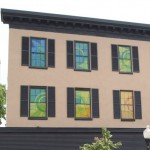
3323 Eastern Ave
Southeast CDC
Monica Broere, Amanda Smit-Peters, Mis Raices, 2013
The Southeast Community Development Corporation has a bright painted screen in every window on its upper stories. Displaying a spectrum of bright color across the front of the building the patterns of the screens were based on the concept of quilt squares. Quilting symbolizes the union of differing traditions and contrasting cultures in a unique manner. These screen represent the multiple people who make up the fabric of the Highlandtown community coming together regularly to strengthen their community. The screens were painted by community members, including Mis Raices (“My Roots”), a Latino women’s group from Patterson Park Public Charter School.
“It doesn’t look like a big job from the ground, but it was a huge job,” Smit-Peters told the tour group. Each of those windows is as tall as a person. That’s a lot of painting and a lot of paint.”
For more information , join our email list by contacting Amanda Smit-Peters: amanda@southeastcdc.org. Next time you are in Highlandtown, remember to look up!


